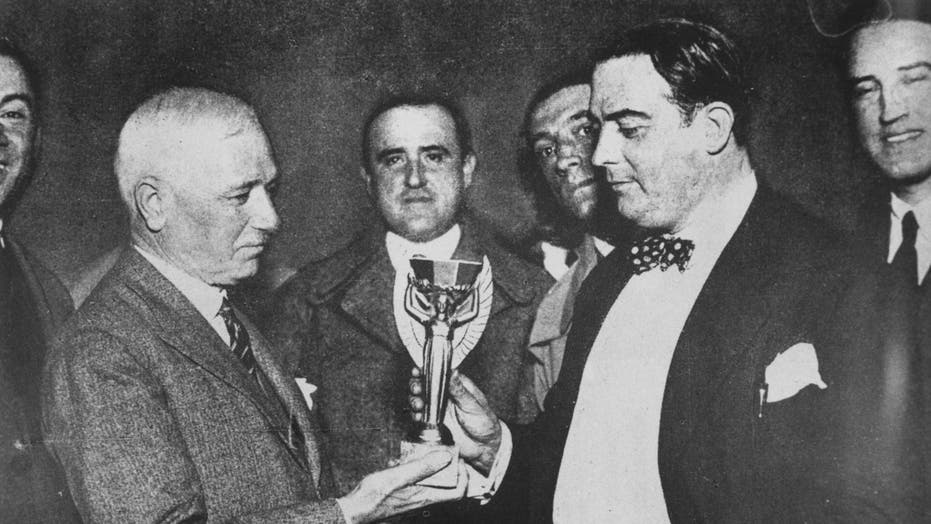On the early morning hours of December 20, 1983 in Rio de Janeiro, the most coveted prize in the world of sports disappeared without a trace.
The Jules Rimet Trophy, a gold-plated statue of Nike, the Greek goddess of victory, was named after a former FIFA president who commissioned it. The statute was stolen that December morning from a bullet-proof glass case deep inside the headquarters of the Brazilian Football Confederation (CBF) when thieves broke through a plywood backing.
A desperate search by authorities in the soccer-mad country ensued, with some speculating that the trophy was melted down into gold bars and some saying that Brazil never actually had the real Jules Rimet in its possession but instead had a replica. Despite a national search, the trophy was never found and today its disappearance remains one of the great mysteries in sports history.
The search for the trophy is to conspiracy theorists, soccer officials and even notorious, power-hungry world leaders something like what the Holy Grail is to treasure hunters and religious historians.
“The theft caused an even bigger outcry than in 1966,” wrote Martin Atherton, a professor at the University of Central Lancashire in his book “The Theft of the Jules Rimet Trophy,” referencing the first time the trophy had been stolen, before the 1966 World Cup in England, “and was seen as a matter of national shame in Brazil.”
More than any other piece of sports hardware, the Jules Rimet has the most turbulent and muddied history, one that encompasses petty theft, international struggles for power, secret hiding spots and a black and white border collie.
The Art Deco trophy first came into existence when FIFA president Jules Rimet commissioned French sculptor Abel Lafeur to create it in 1930 for the inaugural World Cup which Uruguay won. After remaining in Montevideo for four years, the trophy was given to Italy after that nation won the 1934 World Cup and hung onto it after repeating in 1938.
And that is where the trophy’s history takes a dangerous and uncertain turn.
Hidden From The Nazis In A Shoebox
As World War II raged in Europe, and the Allies toppled the Fascist government of Benito Mussolini, Nazi troops occupied the northern half of the peninsula in 1943. Adolf Hitler ordered his forces to hunt down certain artifacts that he thought would add to his power. Along with the Holy Grail and the Spear of Destiny, the Nazi leader wanted to get his hands on the Jules Rimet.
Italian Football Federation commissioner Ottorino Barassi, however, had other ideas. He took the trophy from the bank in Rome where it was being kept and hid it in a shoebox under his bed. The Nazis never got their hands on the prize – despite raiding Barassi’s house. Consequently, the trophy didn't pass into German hands until a squad from the newly-minted West Germany won the 1954 Cup in Switzerland and hoisted the trophy over their heads.
In the post-War years, the Jules Rimet enjoyed peaceful stays in Uruguay, West Germany and eight years in Brazil. But all that changed four months before the 1966 World Cup was slated to begin in England.
Saved By Pickles, The Dog
On March 20, 1966, while on display as part of a stamp exhibition at Central Hall Westminster in London, the trophy disappeared.
For seven days, English authorities desperately searched for it. No luck.
England’s Football Association even went so far as to ask jeweler George Bird to make a secret replica of the Jules Rimet just in case.
It took the keen senses of a border collie named Pickles to find the trophy, which had been wrapped in newspaper and dumped at the bottom of a South London garden hedge. Pickles discovered it while his owner, dockworker David Corbett, used a nearby payphone.
England won the 1966 Cup, and hung onto the trophy, sometimes displaying the replica instead of the original.
In 1970, Brazil won the Cup for the third time. Rimet himself had intended from the creation of the trophy in 1930 that whatever nation was the first to win the Cup would get to keep it permanently and a new trophy would be commissioned.
There is some disagreement among trophy historians over whether the one the English returned to FIFA and ended up being given to Brazil was the real trophy or Bird’s replica. In either case, for the next 13 years, some version of the Jules Rimet trophy was housed inside the CBF building as a permanent display of Brazil’s dominance in the sport.
“Brazil eats, sleeps and drinks soccer,” Pelé has been quoted as saying. “It lives soccer.”
This obsession with futebol had led CBF director Abrain Tebel to make a comment in 1966 about the loss and recovery of the trophy in England that would prove ironic.
“It would never have happened in Brazil,” Tebel said. “Even Brazilian thieves love soccer and would never commit this sacrilege.”
The Final Theft
Sometime between the late hours of December 19 and early morning of December 20, 1983, two thieves accosted a security guard at the CBF headquarters and tied him up before making their way into room that housed the Jules Rimet trophy. Along with the trophy, the bandits made off with three other prizes claimed by the Brazilian national team – the Equitativa, the Copa Jarrito de Oro and the Copa Independencia.
A second replica of the Jules Rimet was hidden in a strong room nearby and overlooked by the thieves.
While the president of the CBF observed that the “spiritual value of the cup is far greater than its material worth,” and Pelé sympathized with the robbers saying the “people are desperate, without money and without food,” the theft was deemed a major blow the psyche of both Brazilian soccer and its fans.
Despite two arrests, no charges were ever filed against anyone and the trophy remains missing to this day. One of the men arrested, Antonio Carlos Aranha, was later found dead under suspicious circumstances – illustrating both Brazil’s anger and shame that one of its most prized possessions was stolen.
Some have speculated that the trophy was melted down into gold bars, but that theory has been ruled out because the statute was only gold-plated, made primarily of sterling silver.
Despite Brazilian authorities creating another replica of the famed trophy, the theft and subsequent failure to track down the Jules Rimet has been a stain on Brazilian soccer and one of the great mysteries of the sport’s world.
“It is a pity,” Atherton wrote in his book, “that Pickles did not have a Brazilian cousin to emulate his feat of 1966 when the trophy was stolen again.”


